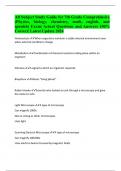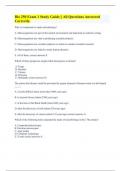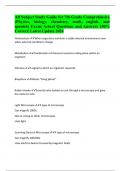Microscopes and cells Study guides, Class notes & Summaries
Looking for the best study guides, study notes and summaries about Microscopes and cells? On this page you'll find 692 study documents about Microscopes and cells.
Page 3 out of 692 results
Sort by

-
IB Biology Unit 1 Latest Update Graded A+
- Exam (elaborations) • 18 pages • 2024
- Available in package deal
-
- $9.99
- + learn more
IB Biology Unit 1 Latest Update Graded A+ Cell theory 3 main principles All organisms are composed of one or more cells cells are the smallest units of life all cells come from pre-existing cells 7 functions of life (MR H GREN) metabolism reproduction homeostasis growth excretion response nutrition Paramecium unicellular membrane of the kingdom known as Protista. Look at powerpoint on isa247 to see how this organism displays the functions of life. chlorella single-cell...

-
All Subject Study Guide for 7th Grade Comprehinsive (Physics, biology, chemistry, math, english, and spanish) Exam| Actual Questions and Answers 100% Correct| Latest Update 2024
- Exam (elaborations) • 49 pages • 2024
-
- $12.49
- + learn more
Homeostasis When organisms maintain a stable internal environment even when external conditions change Metabolism Combination of chemical reactions taking place within an organism Stimulus A signal to which an organism responds Biosphere Means "living planet" Robert Hooke Scientist who looked at cork through a microscope and gave the name to cells Light Microscope A type of microscope Can magnify 1000x Not as strong as other microscopes Uses light Scanning Electron Microscope A typ...

-
Bio 250 Exam 1 Study Guide || All Questions Answered Correctly.
- Exam (elaborations) • 21 pages • 2024
- Available in package deal
-
- $12.99
- + learn more
Why is it important to study microbiology? A. Microorganisms are part of the natural environment and important to nutrient cycling. B. Microorganisms are vital to producing essential products. C. Microorganisms are excellent subjects on which to conduct scientific research. D. Microorganisms are linked to many human diseases. E. All of these. correct answers E Which of these groups are single-celled and possess a nucleus? A. Fungi B. Bacteria C. Viruses D. Protozoa ...

-
Bio principles Exam 2 – Brooks Latest Update Graded A+
- Exam (elaborations) • 63 pages • 2024
- Available in package deal
-
- $11.99
- + learn more
Bio principles Exam 2 – Brooks Latest Update Graded A+ Cytology the study of cells Robert Hooke - observed cork could float - discovered a honeycomb-like structure in a cork slice using a primitive compound microscope - only saw cell walls as this was dead tissue - coined the term "cell" for these individual compartments he saw Two types of microscopes: 1. Light Microscope 2. Electron Microscope Light Microscope - light is focused on specimen by a glass condenser lens -...

-
Bio principles Exam 2 – Brooks Latest Update Graded A+
- Exam (elaborations) • 63 pages • 2024
-
- $12.99
- + learn more
Cytology the study of cells Robert Hooke - observed cork could float - discovered a honeycomb-like structure in a cork slice using a primitive compound microscope - only saw cell walls as this was dead tissue - coined the term "cell" for these individual compartments he saw Two types of microscopes: 1. Light Microscope 2. Electron Microscope Light Microscope - light is focused on specimen by a glass condenser lens - the image is magnified by an objective lens and an ocular lens - proj...

-
Brooks Biological Principles Exam 2 Latest Update with Verified Solutions
- Exam (elaborations) • 38 pages • 2024
-
- $11.49
- + learn more
Cytology the study of cells Cell Theory all living things are composed of cells and come from living cells Robert Hooke one of the first to use microscope, observing a piece of cork from the stem of plants, where he found chambers arising in the idea of a cell. Light Microscope takes pictures of large atoms. nucleus, not electrons Scanning Electron Microscope electrons are reflected off of a specimen and are analyzed by a computer to create a 3D image Transmission Electron Microscope Mic...

-
IB Biology 1.2 Latest Update Already Passed
- Exam (elaborations) • 6 pages • 2024
- Available in package deal
-
- $8.99
- + learn more
IB Biology 1.2 Latest Update Already Passed Resolution Resolution is defined as the shortest distance between two points that can be distinquished Explain why electron microscopes have a better resolution than light microscopes because the wavelength of the electrons is thousands of times smaller than the wavelength of light. Ultrastructure all the structures of a biological specimen that are at least 0.1 nm in their smallest dimension Something that electron microscopes can se...

-
All Subject Study Guide for 7th Grade Comprehinsive (Physics, biology, chemistry, math, english, and spanish) Exam| Actual Questions and Answers 100% Correct| Latest Update 2024
- Exam (elaborations) • 49 pages • 2024
-
- $17.99
- + learn more
Homeostasis When organisms maintain a stable internal environment even when external conditions change Metabolism Combination of chemical reactions taking place within an organism Stimulus A signal to which an organism responds Biosphere Means "living planet" Robert Hooke Scientist who looked at cork through a microscope and gave the name to cells Light Microscope A type of microscope Can magnify 1000x Not as strong as other microscopes Uses light Scanning Electron Microscope A typ...

-
MMSC490 Practice Exam 1 (100% Accurate Answers)
- Exam (elaborations) • 19 pages • 2023
- Available in package deal
-
- $11.49
- + learn more
cytoplasmic organelles are: a. absent in prokaryotic cells and present in eukaryotic cells. b. present in both prokaryotic and eukaryotic cells. c. present in prokaryotic cells and absent in eukaryotic cells. d. absent in both prokaryotic and eukaryotic cells. correct answers a. absent in prokaryotic cells and present in eukaryotic cells E. coli is a useful model system for molecular biology studies because: a. it has a small genome. b. it reproduces rapidly. c. mutants can easily be i...

-
PLTW: Principles of Biomedical Sciences, National Exam Questions And Answers Graded A+
- Exam (elaborations) • 29 pages • 2024
- Available in package deal
-
- $7.99
- + learn more
Prophase I - crossing-over occurs between tetrads Metaphase I - Paired homologous chromosomes line up across the center of the cell Anaphase I - Spindle fibers pull each homologous chromosome pair toward an opposite end of the cell Telophase - A nuclear membrane forms around each cluster of chromosomes and cytokinesis follows, forming two new cells Prophase II - Chromosomes consist of two chromatids, but they do not pair to form tetrads Telophase II - A nuclear membrane forms around each ...

How did he do that? By selling his study resources on Stuvia. Try it yourself! Discover all about earning on Stuvia


